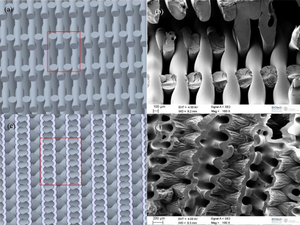
A promising method for obtaining ceramic components with additive manufacturing (AM) is to use a two-step process of first printing the artifact in polymer and then converting it to ceramic using pyrolysis to form polymer derived ceramics (PDCs). AM of ceramic components using PDCs has been demonstrated with a number of high-cost techniques, but data is lacking for fused filament fabrication (FFF)-based 3-D printing. This study investigates the potential of lower-cost, more widespread and accessible FFF-based 3-D printing of PDCs. Low-cost FFF machines have a resolution limit set by the nozzle width, which is inferior to the resolutions obtained with expensive stereolithography or selective laser sintering AM systems. However, to match the performance a partial PDC conversion is used here, where only the outer surface of the printed polymer frame is converted to ceramic. Here the FFF-based 3-D printed sample is coated with a preceramic polymer and then it is converted into the corresponding PDC sample with a high temperature pyrolysis process. A screening experiment is performed on commercial filaments to obtain ceramic 3-D prints by surface coating both hard thermoplastics: poly lactic acid (PLA), polycarbonate (PC), nylon alloys, polypropylene (PP), polyethylene terephthalate glycol (PETG), polyethylene terephthalate (PET), and co-polyesters; and flexible materials including: flexible PLA, thermoplastic elastomer and thermoplastic polyurethane filaments. Mass and volume changes were quantified for the soaking and pyrolysis steps to form a hollow ceramic skin. All 3-D printing materials extruded at 250 microns successfully produced hollow ceramics skins of less than 100 microns. Details on the advantages and disadvantages of the different 3-D printing polymer precursors are discussed for this processing regime. The novel results developed here can be used to choose FFF-based polymers to use for PDC processing on a wide range of applications such as heat exchangers, heat sinks, scaffoldings for bone tissue growth, chemical/ gas filters and custom scientific hardware.
Highlights[edit | edit source]
- Additive manufacturing of polymer derived ceramics with fused filament fabrication.
- Producing ceramics with hollow struts by surface coating with preceramic polymers.
- Creating a multi-level porous system with stable geometry.
- All 3-D printing materials produced ceramics skins of less than 100 microns.
Keywords[edit | edit source]
polymer derived ceramics; fused filament fabrication; material extrusion; 3D printing; open-source platform





